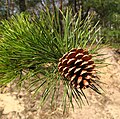User:Carlos Iraheta/sandbox
| Pitch pine | |
|---|---|

| |
| Scientific classification | |
| Kingdom: | Plantae |
| Clade: | Tracheophytes |
| Clade: | Gymnospermae |
| Division: | Pinophyta |
| Class: | Pinopsida |
| Order: | Pinales |
| Family: | Pinaceae |
| Genus: | Pinus |
| Subgenus: | P. subg. Pinus |
| Species: | P. rigida
|
| Binomial name | |
| Pinus rigida | |

| |
Pinus rigida
[edit]Pinus rigida, or more commonly denominated the pitch pine, candlewood pine, and torch pine[2]. This tree Is a medium sized pine, which is native to eastern North America[2]. It can be found in two pockets along the St Lawrence River in southern Quebec and Ontario and more prominently occurs from central Maine south to Georgia and as west as Kentucky[3]. It is found in places where other species would find unsuitable for growth such as acidic, sandy, and low nutrient soils.
Taxonomy
[edit]Scientific name: Pinus rigidia
It was given its name by British botanist Philip Miller. It belongs to the Pinaceae family and the subgenus Diploxyon along other hard pines[2].
Distripution
[edit]Pitch pines if found more prominently in pine barrens vegetation in the northeastern United States[4]. It is known as a pioneer species and is often the first tree to vegetate a site after it has been cleared away. In extreme conditions, it is a climax vegetation type. But in most cases, it is replaced by oaks and other hardwoods. In the Appalachian mountains, it grows on ridges alongside Pinus virginiana and Pinus pungens it is not uncommon for these species to hybridize with each other. This pine can be found from dry acidic sandy uplands to swampy lowlands and can survive in very poor conditions.[2]
Description
[edit]The pitch pine is a medium sized tree 6–30 m (20–98 ft.) tall. It is a hard pine and has multiple growth forms. It can remain as an under story shrub that does not grow taller than 1m (3ft) or under optimal conditions it can grow 25m (82ft) [2]depending on soil characteristics, climate, and environment. It is irregular in shape, branches are usually twisted and it does a poor job at self-pruning. Trunks are usually straight with a slight curve to them, they are covered in irregular, thick, large plates of bark to protect the trees cambium layer from fires. You can find needles and cones developing directly on the trunk and branches. Needles are in fascicles (bundles) of three, about 6–13 cm (2.4–5.1 in) in length, and over 1 mm (0.039 in) thick and have a twist to them[5]. They retain their needles for 2 to three years before falling to the ground. Female cones are found more in the upper portion of the tree and are oval in shape with thick scales that have spikes on the umbo. It takes two years for the female cones to mature after fertilization. Male cones are found lower on the tree and form at the base of the current year's growth. The pitch pine cannot self-pollinate and is wind pollinated. It grows rapidly when young but slows growth after 51 years old[2]. By 90 years of age, the amount of height gained in minimal. The pine starts producing cones after 3 years and they can live up to and around 200 years.[2]
Role In Ecosystem
[edit]Pitch pine provides a habitat and offers food for many wildlife species. They are used as cover and nesting for birds such as the Pine warbler, Wild turkey, red-cockaded woodpecker, great-crested flycatchers, blue jays, black-capped chickadees, black-and-white warblers, Nashville warblers, and chestnut-sided warblers[2]. Deer consume seedlings and and new sprouts. and small mammals and birds eat the seeds.
Uses to Humans
[edit]The pitch pine is used as a reforestation species in sites that have been turned acidic like in mining operations and in landfills. acheology indicates that the Iroquois, Shinnecock, and Cherokee all utilized pitch pine[6]. The Iroquois used the pitch to treat rheumatism, burns, cuts, and boils[6]. Pitch also worked as a laxative. A pitch pine poultice was used by both the Iroquois and the Shinnecock to open boils and to treat abscesses. The Cherokee used pitch pine wood in canoe construction and for decorative carvings.
The wood is often to twisted to be used as lumber. Pitch pine wood is coarse grained and resinous it has been noted as an excellent source of turpentine.[6]
Gallery
[edit]-
New growth and pollen cones
-
Cone and needles
-
View north from a fire tower on Apple Pie Hill in the New Jersey Pine Barrens. The vast pine forest is almost entirely made up of Pinus rigida.
 | This is a user sandbox of Carlos Iraheta. You can use it for testing or practicing edits. This is not the sandbox where you should draft your assigned article for a dashboard.wikiedu.org course. To find the right sandbox for your assignment, visit your Dashboard course page and follow the Sandbox Draft link for your assigned article in the My Articles section. |
- ^ "Pinus rigida". IUCN Red List of Threatened Species. 2013.1. 2013. 2013.
{{cite journal}}: Unknown parameter|assessor=ignored (help); Unknown parameter|downloaded=ignored (help) {{cite iucn}}: error: no identifier (help) - ^ a b c d e f g h "Pinus rigida". www.fs.fed.us. Retrieved 2017-04-26.
- ^ GBIF. "Pinus rigida Mill. - Verbatim View". www.gbif.org. Retrieved 2017-04-26.
- ^ "Plant Database". hort.uconn.edu. Retrieved 2017-04-26.
- ^ "Pinus rigida Fact Sheet". dendro.cnre.vt.edu. Retrieved 2017-04-26.
- ^ a b c "About Pitch pine, Pinus rigida". www.treesforme.com. Retrieved 2017-04-26.




